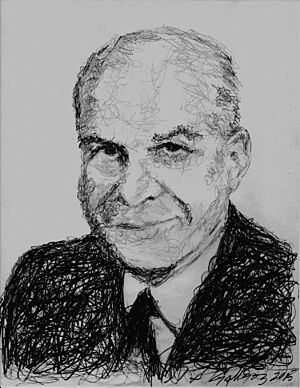Gerald James Whitrow facts for kids
Gerald James Whitrow (born June 9, 1912 – died June 2, 2000) was a smart British scientist. He was a mathematician, which means he studied numbers and shapes. He was also a cosmologist, someone who studies the universe and how it began. Plus, he was a science historian, meaning he learned about the past of science.
Contents
About Gerald Whitrow
Gerald Whitrow was born on June 9, 1912, in a place called Kimmeridge in Dorset, England. He was the older son of William and Emily Whitrow.
His Education and Early Work
After finishing school at Christ's Hospital, Gerald won a special scholarship. This allowed him to study at Christ Church, Oxford University in 1930. He earned his first degree there in 1933.
He continued his studies at Merton College, Oxford, from 1935 to 1937. He received his MA degree in 1937 and his PhD in 1939. While at Oxford, he worked with Professor Edward Arthur Milne. They explored a different idea about relativity.
Working During World War II
During World War II, Gerald Whitrow worked for the government. He was a scientific officer for the Ministry of Supply. His job involved research for defense, like studying how bullets and rockets fly (called ballistics). He worked at places like Fort Halstead and Cambridge.
Teaching and Research Career
After the war, he started teaching at the Imperial College, London. First, he was a lecturer, then a reader of applied mathematics in 1951. In 1972, he became a professor of the history of mathematics.
Why Space Has Three Dimensions
In 1955, Gerald Whitrow wrote an important paper. It was called "Why Physical Space Has Three Dimensions." He looked into the idea of space having more or fewer than three dimensions.
What if Space Had More Dimensions?
He thought about what would happen if space had four dimensions. If the rules of gravity and electromagnetism stayed the same, things would change a lot. The way gravity pulls things would become an "inverse cube law." This means planets would not stay in stable orbits around stars. Also, atoms would not be stable. These problems would get even worse if space had more than four dimensions.
What if Space Had Fewer Dimensions?
He also considered what if space only had two dimensions. In a two-dimensional world, waves (like light or sound) would not spread out easily. They would also be harder to reflect. This would make it very difficult for complex systems, like living things, to work properly.
His Conclusion
Gerald Whitrow concluded that life, as we know it, would not be possible in space with more or fewer than three dimensions. This shows how special our three-dimensional world is!
Later Life and Contributions
Gerald Whitrow retired in 1979. After that, he was an emeritus professor and a senior research fellow at Imperial College. For most of his life, he was a Fellow of the Royal Astronomical Society. He did a lot for them by organizing their important library and archives. He was in charge of the library committee from the early 1960s until 1975.
In 1971, he helped start the British Society for the History of Science. He also had a strong interest in libraries at the Athenaeum Club. He was a member there from 1957 and even led their library committee.
His Main Research Areas
His main work was in cosmology and astrophysics. Cosmology is the study of the universe, and astrophysics is the study of stars and galaxies. He was also very interested in the history and philosophy of science. He especially focused on the idea of time.
One of his most famous books was The Natural Philosophy of Time. His work made him a central figure in the study of time. Because of this, he became the first president of the International Society for the Study of Time in 1966.
Work on Cosmic Background Radiation
In 1964, Whitrow published an important paper with B. D. Yallop. It was about the cosmic background radiation. This is a faint glow of radiation left over from the very early universe, sometimes called the "Primordial Fireball."
- Title: The background radiation in homogeneous isotropic world models, I.
- Authors: Whitrow, G. J. & Yallop, B. D.
- Journal: Monthly Notices of the Royal Astronomical Society, Vol. 127, p. 301
His Legacy
Gerald Whitrow passed away on June 2, 2000. After a private funeral, his ashes were spread on Christ Church Meadow. The Royal Astronomical Society now gives out a special award in his name every two years. It is called the Gerald Whitrow Lectureship.


